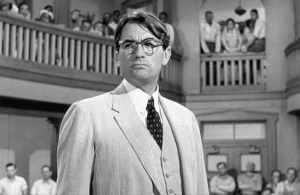An old post I wrote back when I was trying to figure out why…
…
In a past life I was a business lawyer, as opposed to a trial lawyer. However, I did go to a respected trial lawyer-oriented school, where we got to “play lawyer” frequently. And I did a bit of courtroom work in my earliest years of practice.
So, I have an appreciation for courtroom theatrics.
The most dramatic part of any trial, generally, is the closing argument. It’s where the lawyer supplies the why for the jury. The arguments that work best are the ones that are more than just a rehashing of the facts. They inspire the jury to come to the conclusion that the lawyer is paid to produce. The guilty or not guilty verdict, in the case of a criminal trial, or the nice fat damage award, in case of a civil one.
Even though fictitious, my favorite jury argument of all time is the one made by Atticus Finch in the classic film, To Kill a Mockingbird. Not only is it great courtroom drama, but it is one of the most inspirational Hollywood moments of all time…in my opinion.
I recently read Twyla Tharp’s book, The Creative Habit. One thing that really stood out to me is her insistence that every creative work have a “spine.” What’s that? Well, although it’s hard for me to describe succinctly, I believe it’s sort of like a therapeutic metaphor, or an object, activity, or idea that is used as a symbol for deeper meaning.
I’m not altogether cetain what Harper Lee’s spine was for her Pulitzer Prize winning book, but I would venture to say, perhaps, youthful innocence, contrasted with the evil of prejudicial hate.
Perhaps her spine was a call to innocence.
Tharp clearly states that the creator’s “spine” is not always revealed to the consumer. But it’s always at the forefront of the creator’s mind throughout the creation process.
I was thinking yesterday about what could or should serve as the spine for this creative undertaking upon which I have embarked, the blog Revolutionary Misfit.
First off, I want the content to inspire…to supply the why…much like a trial lawyer in a jury trial closing argument.
Since that’s what Atticus was attempting to do and since his attempt was deeply inspirational to me, perhaps that should be my spine for Revolutionary Misfit.
I want the content delivered within this blog to inspire…to supply the why…much like a trial lawyer in a jury trial closing argument.
It has all the elements I need. His argument pitted the impact of doing the right thing (what Atticus did by taking on the case to begin with) against the prejudicial inclinations of the accusers and of the jury.
It certainly dramatized the mindset of the small us with the attempt by Atticus to inspire Big US thinking…an attempt that failed to achieve its intended result, but was inspirational nonetheless.
Finally, Atticus tried hard to remove the impact blinders the jury was wearing that would prevent them from seeing the path to a positive impact (for Tom Robinson, cetainly, but also for the general idea of racial equality).
The climatic moment was when he delivered the emotionally gripping line, “in the name of God, do your duty…in the name of God, believe Tom Robinson.”
That pretty much sums it up for me. That line supplies the why. The why for impact.
And what is that why?
Our god-given duty to bring good into this world. We do that via our impacts, as varied as they might be.
The why for impact in my opinion is the why for our very existence. We were created for that reason…to bring about the unique good that motivated God to breathe life into us in the first place.
The why for impact in my opinion is the why for our very existence. We were created for that reason…to bring about the unique good that motivated God to breathe life into us in the first place.
So, what does that mean, practically, for Revolutionary Misfit going forward?
It means that the great Atticus Argument meets all requirements for supplying the why of this blog, especially that climactic moment…
in which his powerful words moved me towards the god-given duty for positive impact.
